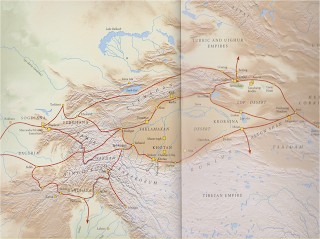From Samarkand to Chang’an: The Itinerant Sogdians
 I. The Ancient Sogdian Letters
I. The Ancient Sogdian LettersIn 1907, under a Han dynasty watchtower northwest of Dunhuang, the Hungarian-British Archeologist Aurel Stein found a mail bag containing 8 letters written in the Sogdian language; 3 of them were too fragmented to read but 5 were relatively intact
B. Stein turned these letters to the British Museum; experts in the Museum and other experts began to try to translate them
C. After several trials and improvements over the past 100 years, we now know the complete content of these 5 letters
D. They were written by Sogdian merchants in 312 CE to other Sogdian merchants on the Silk Road or to their families in Samarkand
II. Who Were the Sogdians?
Sogdians were farming and trading people who lived in the Zarafshan River Valley in today’s Uzbekistan and spoke an Eastern Iranian language
They were ruled by Archamenids from Persia in 5th century BCE, Alexander (and the Seleucid Greek kingdom), and the Kushans.
Even though the Sogdians never had a united and strong kingdom of their own, they were very visible in Central Asia throughout its history.
III. The Rise of Sogdian Merchants on the Silk Road and Elsewhere
From 3rd to 10th century CE the dominant traders on the Silk Road were the Sogdians whose reach encompassed the Byzantine Empire, India and China.
Before the rise of Sogdians, Indians and Persians were prominent in the trade in Eurasia.
This may have been caused by the disruptions brought by Xiongnu’s westward and southward thrust, creating a vacuum for the Sogdians to fill in the central region of the Eurasian continent.
Therefore, not only were the Sogdians prominent in trade with China, but they were also active in South Asia and West Asia
IV. The Master Traders on the Silk Road
The ancient Sogdian letters give clear evidence that trade along the Silk Road mostly took place between Sogdian merchants some of whom were resident in various countries.
Since the Sogdians did not have their own currency, the common medium for trade was the Sassanian gold coins until the 7th century when Tang Chinese coins became the common currency in trade on the Silk Road.
Sogdian merchants brought spices, glassware, jewelry, medicinal material from the West to the East; they brought silk, tea and lacquerware.
They also traded rare animals, slaves, even singers, dancers and acrobats.
V. Sogdian Communities Along the Silk Road and in Eastern China
As trade developed, many Sogdians chose to stay in trading centers, forming their own community and having their own governing system as well as religious institutions (mainly Zoroastrian temples).
Historical records and archeological findings indicate at least 30 such communities from Kashgar in the west end of today’s China to Liaoning province in the northeast.
The leader of a Sogdian trade caravan was called a Sartpaw; the community leader of resident Sogdians was known by the same title.
This quasi autonomous communities often had their own armed forces, religious clergy and other administrative arrangements including the community coffer.
VI. The Integration of Sogdian Communities in the Chinese Society
The Sogdians were identified in Chinese historical records and other documents in the 3rd century.
Sogdians were also recruited into the army and often served in the imperial palace.
Almost all of the Sogdians who stayed in China took one of nine of the existing Chinese surnames; therefore, they were also known in China as a group of people with these nine surnames (“zhao-wu jiu-xing”).
During Tang dynasty, the Sogdians were known as good musicians and dancers; many of the roughly 3000 wine shops in Chang’an were run and staffed by Sogdians.
E. The central Chinese governments began to appoint the Sogdian community leaders as local officials with the title “Sabao”, the Sinicized version of Sartpaw.
F. During Sui and Tang periods, these Sogdian communities were integrated into the local administrative structure as regular “Xiang’s” or “Li’s”. (乡里)
G. Those Sogdian families who stayed in China long enough gradually became indistinguishable from the other Chinese.
VII. Contributions of the Sogdians to China
In addition to music and dance, the Sogdian clothing style became fashionable during the Tang dynasty.
Some rare animals from Africa and other places were introduced by Sogdians.
Sogdians brought their religious practices as well as artifacts which were merged in Chinese Buddhism.
The Sogdian script was later borrowed by the Uyghurs, Mongols and Manchus successively in their own writing system.
The Sogdian merchants greatly enhanced Chinese economy, enriching the material life in China.
Sogdians were mainly or at least partially responsible for the introduction of Zoroastrianism, Manichaeism, and Nestorian Christian faith in China.
VIII. The Most Infamous Sogdian in Chinese History
An Lu Shan (Roxan) was born in China of Sogdian parentage; he became a regional military commander in northeast China.
During the reign of Tang Xuan Zong An Lu Shan, though very trusted by the emperor, started a rebellion which nearly toppled the Tang dynasty and caused decline of Tang power from the point onward.
His rebellion was defeated by the Tang forces with help from the Arabs and Uyghurs.
An Lu Shan has since been a household name in China, in a negative sense.

No comments:
Post a Comment